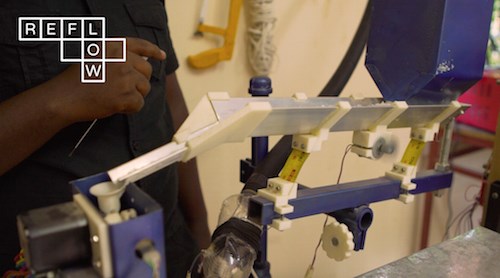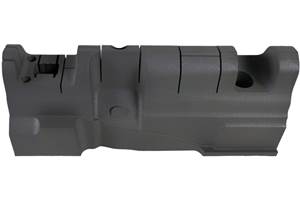Startup Turns Recycled Plastic into 3D Printing Filament
Plenty of companies are taking advantage 3D printing鈥檚 disruptive nature in the manufacturing space, but I came across an Amsterdam-based startup that is taking the disruptive concept even further.
Plenty of companies are taking advantage 3D printing’s disruptive nature in the manufacturing space, but I came across an Amsterdam-based startup that is taking the disruptive concept even further.
Reflow converts recyclable plastic into 3D printing filament using open source technology. Reflow filament is made from recycled PET bottles collected in developing regions, and revenues from the filament go back to the waste collectors who gather these bottles, which the company claims can increase their income by up to 20 times.
Jasper Middendorp, CEO, visited recycling centers in Nairobi, Kenya last year and saw how the waste collection, trade and recycling systems work. He saw that waste collectors collect plastic all day and receive very little money for it. They may earn 10-15 cents per kilogram and, for many, that’s their family’s only income stream. Meanwhile, a kilogram of 3D print filament costs around $30.
“That’s a huge disparity, and the reason for the focus on plastic recycling and 3D printing,” he told Plastics Technology. “Reflow is looking to leverage the exponential growth in the 3D printing market to create value from the waste plastic being collected and to flow that value back into waste picker communities and local manufacturing in developing regions.”
The company has a big task ahead: it aims to turn the growth of 3D printing into income for more than 40 million waste collectors worldwide that collect waste for a living, earning less than $2 a day. But the company believes the impact it will have on these communities and on the environment is significant: every kg of filament sold results in the removal of 120 bottles from the streets and $3 additional income for waste collectors. The company’s aim is to sell 5000 kg of filament in the first three years. If they achieve this goal, waste collectors’ incomes will increase by $200,000 and 6 million plastic bottles will be removed from the street.
Currently, Reflow’s material comes from waste collectors in Dar es Salaam, Tanzania who pick plastic bottles by the road or at designated locations (bars, hotels etc.) and bring them to a satellite collection point or central facility. The plastic is weighed, examined and the waste collector is paid.
Reflow filament is suitable for all 3D FDM printers that are capable of printing in a range of 435°F-455°F, although a heated bed is recommended. Reflow filament can be used in any application where other ABS, PLA and PET filaments are used.
Reflow’s partner , a UK-based charity, has developed an open source extruder that they set up at its partner location, STICLab in Dar es Salaam. The extruder can create 0.5 to 1 kg of filament per hour directly from plastic flakes. It was designed to fit the niche between the cheap home extruders that lack consistency for consumer production and the expensive industrial machines with high throughput. Middendorp said that they are in the process of improving on this second-generation extruder to a full production model over the next 6 to 9 months so that they will be able to fulfill purchase orders for the filament by the beginning of 2017.
Middendorp said that the company has some big technical and impact challenges in the coming months, but adds, “We are ready for them, and any others that come up.”
“On the technical side, there is work to be done with the extruder to make sure it reliably produces high quality filament. It’s very important for us to make a filament whose quality is as good as filament made from virgin plastic. We know no one wants to print with a sub-par filament, regardless of its ethical and sustainable elements,” he said. “We are also working on finding a reliable, continuous source of plastic, building relationships with waste collectors and tracking and tracing the money paid out to collectors in order to measure our impact.”

Related Content
5 Trends in 3D Printed Injection Mold Tooling
3D printing has moved beyond conformal cooling, and is now being applied to injection molds more broadly. Observations on additively manufactured mold tooling from the Plastics Technology Expo — PTXPO 2025.
Read MoreNPE 2024: Additive Manufacturing Assisting, Advancing Plastics Processing
Exhibitors and presenters at the plastics show emphasized 3D printing as a complement and aid to more traditional production processes.
Read More420 Stainless Steel Now Qualified With TrueShape 3D Printing Technology
NPE2024: Mantle's additive manufacturing technology is designed for precision tooling.
Read MoreKraussMaffei Nears Completion of Corporate Headquarters Move
The 185-yr old German maker of plastics processing machinery is shifting to a more than 200,000-m2 greenfield site in Parsdorf.
Read MoreRead Next
See Recyclers Close the Loop on Trade Show Production Scrap at NPE2024
A collaboration between show organizer PLASTICS, recycler CPR and size reduction experts WEIMA and Conair recovered and recycled all production scrap at NPE2024.
Read MoreFor PLASTICS' CEO Seaholm, NPE to Shine Light on Sustainability Successes
With advocacy, communication and sustainability as three main pillars, Seaholm leads a trade association to NPE that ‘is more active today than we have ever been.’
Read MoreMaking the Circular Economy a Reality
Driven by brand owner demands and new worldwide legislation, the entire supply chain is working toward the shift to circularity, with some evidence the circular economy has already begun.
Read More














